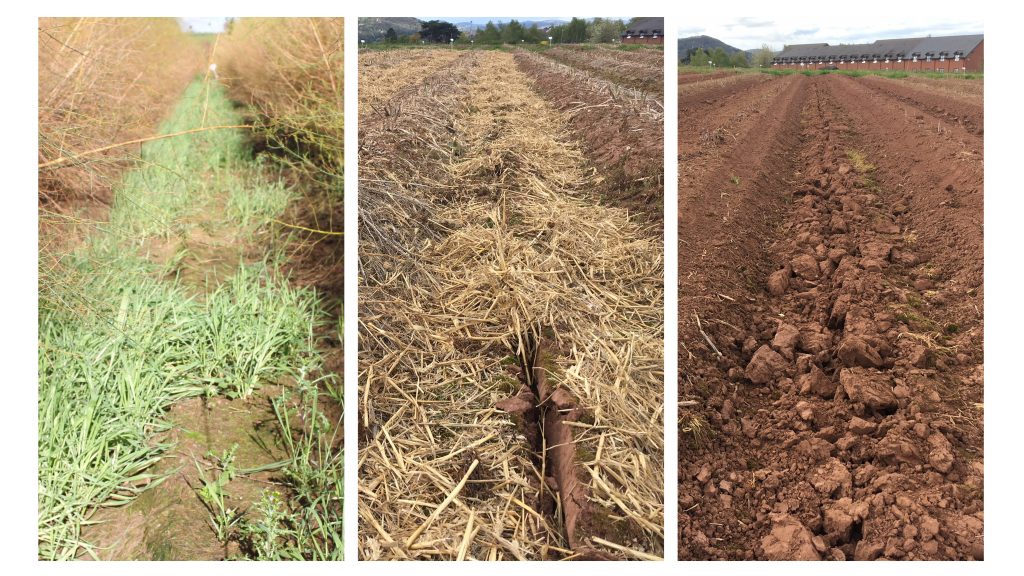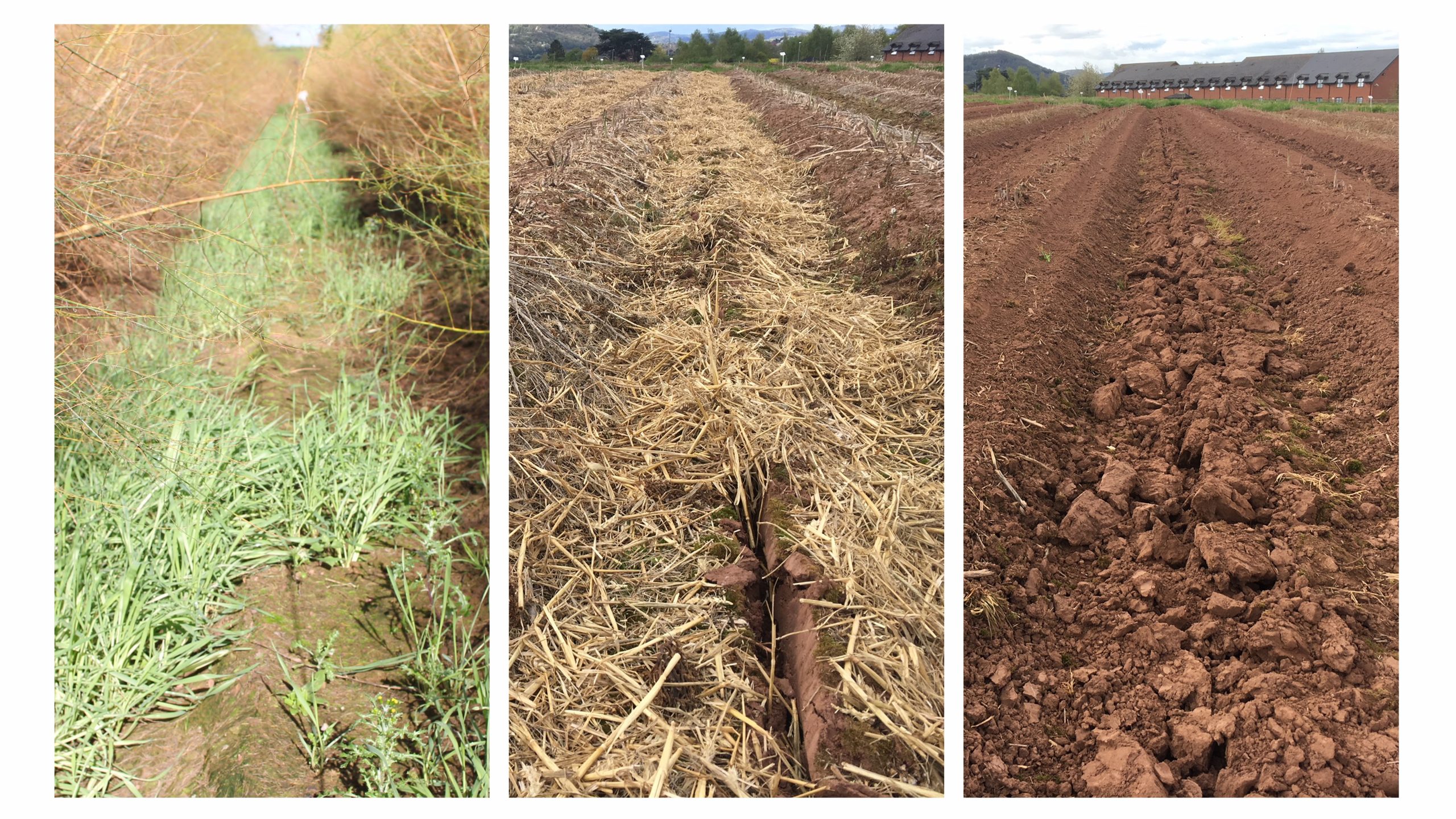Sustainable soil management for asparagus stand longevity
In the UK, ‘asparagus decline’ due primarily to crown and root rot caused by Phytophthora asparagi and Fusarium species can result in up to 60% loss of stand amounting to up to £16M in lost revenue per annum. With key operations causing the damage, finding practical solutions to this problem is essential. Only a 10% reduction in yield losses due to ‘asparagus decline’ would amount to a saving of >£1.6M to UK asparagus growers per year. A team from Cranfield University, in collaboration with Cobrey Farms, have been sponsored by AHDB (AHDB Horticulture FV 450a), to develop a suite of best management practices (BMPs) targeted at either preventing or remediating soil compaction in inter-bed wheelings. The main aims of these BMPs are to improve soil structure, reduce soil erosion risk, promote asparagus yields and stand longevity.
Soil management problem
The compaction caused by standard operational procedures, is often eliminated by sub-soiling in crop production. For asparagus, sub-soiling of inter-bed wheelings is used to promote infiltration of water, which reduces the amount of surface water run-off and therefore reduces the risk of soil erosion. However, sub-soiling as well as annual re-ridging are highly invasive. These operations cause damage to asparagus storage roots making the crop susceptible to crown and root rot promoting yield decline.
Experimental field trial
The length of field trial is critical to understanding the impact of management decisions. Changes, in particular improvements to soil structure delivered by modification to practices, can take years before their effect is fully appreciated. Therefore, in order to prove BMP advice, a long-term experimental field trial was established in April 2016 on a 4.5 ha asparagus field in Ross-on-Wye, south eastern Herefordshire, England. The trial comprises 48 experimental plots of the variety Gijnlim, which represents about 70% of UK field grown asparagus.
A range of soil management practices were established that included mulch applications in the wheelings, companion cropping, shallow soil disturbance (SSD, also called sub-soiling) and conventional ridging (R) practices against zero-tillage (not ridged nor sub-soiled) options.
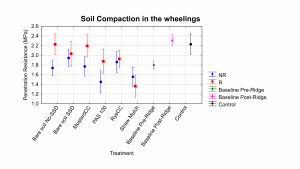
The impacts of different soil management practices are being evaluated via measurements on asparagus storage root distribution, yields and general crop health observations. Changes to soil structure were assessed using a selection of grower-friendly soil structure indicators, such as speed of water infiltration, penetrative resistance and visual soil assessment. Based on previous research undertaken by Cranfield University and Cobrey Farms, it had been established that SSD in association with straw or PAS 100 compost application reduced run-off and soil erosion by more than 80%. Therefore, PAS 100 compost and straw mulch were used in this experiment in SSD trials, to test effects of long-term mulch application on asparagus performance and soil structure. Literature often highlights that the generation of biopores through a bio-drilling effect of cover crops and companion crops in compacted soils can result in increased yield of follow-on cash crops. Plant roots ‘engineer’ the soil structure by penetrating and displacing it, creating air pores, by depositing adhesive compounds which encourage soil aggregation, and via a range of other root deposits which provide energy and nutrient sources for soil biota. The importance of canopy cover, stem density and root density in reducing soil erosion has also been demonstrated. Use of companion crops therefore presents an opportunity to provide soil protection and erosion control within asparagus production systems as well as bio-remediate soil structure. Companion crops included in the trial are rye (Cereale secale), which is commonly used amongst North American asparagus growers and mustard (Sinapis alba), which was selected for its extensive rooting system and associated bio-drilling potential. However, to date, companion cropping has not been adopted within UK asparagus systems as a common practice. Yet the use of companion crops in UK asparagus production as a replacement for conventional sub-soiling practices presents an opportunity to provide soil structural rejuvenation, alleviation of soil compaction and soil erosion control.
Management practice effects on soil structure
Three years after the establishment of the management treatments, meaningful differences can be observed between several BMP treatments. The Rye companion crop non-ridged (NR) did not alleviate soil compaction in any depth. It was in fact more compact than the bare soil zero-tillage treatment. The Rye NR treatment has also been consistently associated with lower yields than the bare soil zero-tillage treatment, suggesting that soil structure might be playing a crucial role in sustaining high asparagus yields. In non-ridged treatments, there was generally good soil structure and high infiltration rates. As expected, soils that were less compacted were associated with increased infiltration rates and soil moisture. Although asparagus in general prefers light, well drained soils, it can temporarily tolerate wet heavier soil conditions. Problems may arise in the winter/spring when the water ponds on the surface, increasing risks of disease transmission (in particular Phytophthora crown rot). Mulches not only retain water in the deeper horizons, but also on the surface. The effect of high moisture soils on asparagus root systems and susceptibility to diseases is yet to be fully understood. Higher soil compaction in the inter-bed wheelings was in most cases associated with ridging. Sub-soiling partially alleviated compaction caused by ridging, however, improvements to soil structure were also seen with the zero-tillage treatments. Therefore, given the additional cost of two further passes required to sub-soil, the use of post-ridging sub-soiling is economically questionable. Mulch applications (especially straw mulch) not only prevented soil compaction but also remediated the pre-existing baseline soil compaction. Straw mulch was the only treatment where ridging did not compact soil further. The use of mulches also lead to better soil structure than seen with the use of companion crops. This could be due to a higher observed abundance of earth worms and other soil biota, which were seen in the mulch plots, and have previously been proven to have a positive effect on soil structure. This will be further studied in 2020.
Water infiltration was significantly better in PAS 100 compost plots as compared to other treatments. This also corresponded with observed improvements to soil structure.
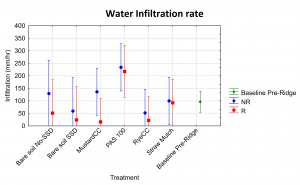
Asparagus Root System
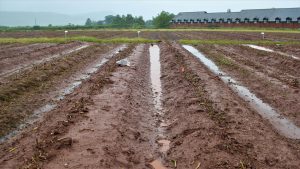
Although we cannot confirm yet whether size of the root system tells us anything about asparagus yields directly, several strong trends have been observed between root and soil data. Most notably we found that higher infiltration rate in inter-bed wheelings of ridged treatments was strongly associated with higher root masses at 30-60cm depths and 60cm distance from the crown. In contrast, where the soil compaction of the soil was higher, fewer roots (lower root masses) were found at 30-60cm depth at a distance of 30cm from the crown, while more roots (higher root masses) were found closer to the soil surface at 60cm distance from the crown. Initial results of this trial demonstrate that soil compaction and tillage operations affect the size of the root system. The trials will continue to investigate how this affects yield and stand longevity in future years.
Over the next 3-4 years, this field experiment will continue to generate valuable insights on the efficacy of best soil management practices to prevent soil compaction and erosion and increase stand longevity.







